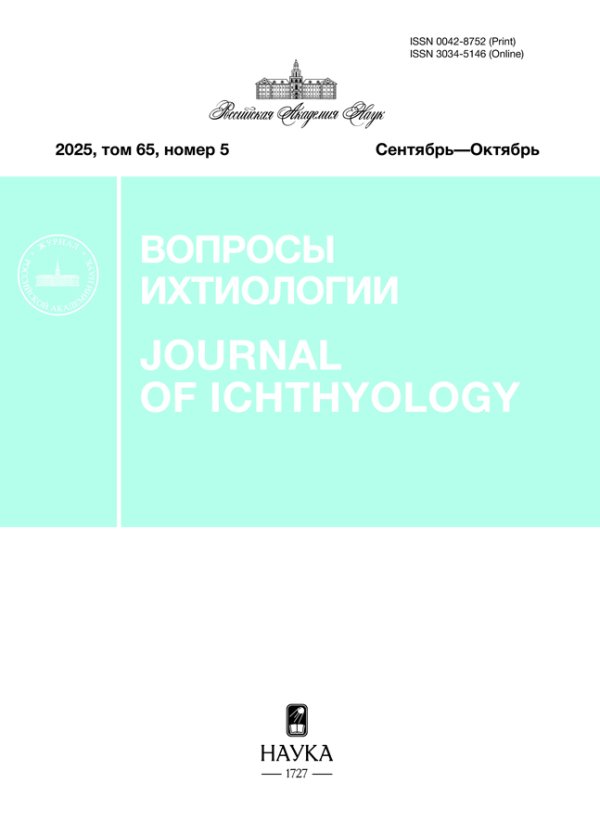Separated by Space and Time but United by Kinship: Phylogeographical and Phylogenetic History of Two Species of Eleginus (Gadidae) Based on the Polymorphism of Cyt b Mitochondrial DNA Gene
- Authors: Chikurova E.A.1,2, Orlov A.M.2,3, Shchepetov D.M.4,5,6, Orlova S.Y.1,3
-
Affiliations:
- Russian Federal Research Institute of Fisheries and Oceanography—VNIRO, Moscow, Russia
- Severtsov Institute of Ecology and Evolution, Russian Academy of Sciences, Moscow, Russia
- Institute of Oceanology, Russian Academy of Sciences, Moscow, Russia
- Koltzov Institute of Developmental Biology, Russian Academy of Sciences, Moscow, Russia
- Moscow Power Engineering Institute, Moscow, Russia
- National Research University—Higher School of Economics, Moscow, Russia
- Issue: Vol 63, No 2 (2023)
- Pages: 131
- Section: Articles
- URL: https://journals.rcsi.science/0042-8752/article/view/135165
- DOI: https://doi.org/10.31857/S0042875223020042
- EDN: https://elibrary.ru/EYEFIT
- ID: 135165
Cite item
Full Text
Abstract
Fishes of the genus Eleginus (Gadidae) are typical representatives of the ichthyofauna of the Northern Hemisphere; they play an important trophic role in the marine ecosystems of the Arctic and North Pacific and serve as targets of commercial and artisanal coastal fishing in many areas of the Russian North and Far East, as well as in areas of the coast of Alaska and northern Japan. The level of knowledge about the intraspecific organization of representatives of the genus Eleginus that is necessary for the rational exploitation of their stocks remains insufficient and their interspecific relationships have so far been analyzed using limited materials. This paper presents the first study of the interspecific relationships and intraspecific structure of navaga (E. nawaga) and saffron cod (E. gracilis) using a large-scale material (986 specimens in 29 samples from most of the species ranges) based on analysis of the polymorphism of mtDNA gene Cyt b. It is shown that they are independent, genetically differentiated species and their comparison with representatives of the genus Microgadus indicates that both species of the genus Eleginus might originate from a common ancestor close to M. proximus, while the divergence in the genus Microgadus occurred much earlier. Data on the haplotypic composition of saffron cod samples inhabiting areas from the Peter the Great Bay to Alaska waters and navaga samples inhabiting areas from the White Sea to the Ob Bay of the Kara Sea are given, which makes it possible to consider the phylogeographic history of both species and their intraspecific organization within the studied areas. Three groups can be distinguished for saffron cod: (1) Pacific–Japanese–Sakhalin group, (2) Chukchi–Bering seas group, and (3) intermediate group, which includes samples from the Sea of Okhotsk and waters of the northern Kurils.
About the authors
E. A. Chikurova
Russian Federal Research Institute of Fisheries and Oceanography—VNIRO, Moscow, Russia; Severtsov Institute of Ecology and Evolution, Russian Academy of Sciences, Moscow, Russia
Email: orlov@vniro.ru
Россия, Москва; Россия, Москва
A. M. Orlov
Severtsov Institute of Ecology and Evolution, Russian Academy of Sciences, Moscow, Russia; Institute of Oceanology, Russian Academy of Sciences, Moscow, Russia
Email: orlov@vniro.ru
Россия, Москва; Россия, Москва
D. M. Shchepetov
Koltzov Institute of Developmental Biology, Russian Academy of Sciences, Moscow, Russia; Moscow Power Engineering Institute, Moscow, Russia; National Research University—Higher School of Economics, Moscow, Russia
Email: orlov@vniro.ru
Россия, Москва; Россия, Москва; Россия, Москва
S. Yu. Orlova
Russian Federal Research Institute of Fisheries and Oceanography—VNIRO, Moscow, Russia; Institute of Oceanology, Russian Academy of Sciences, Moscow, Russia
Author for correspondence.
Email: orlov@vniro.ru
Россия, Москва; Россия, Москва
References
Supplementary files










